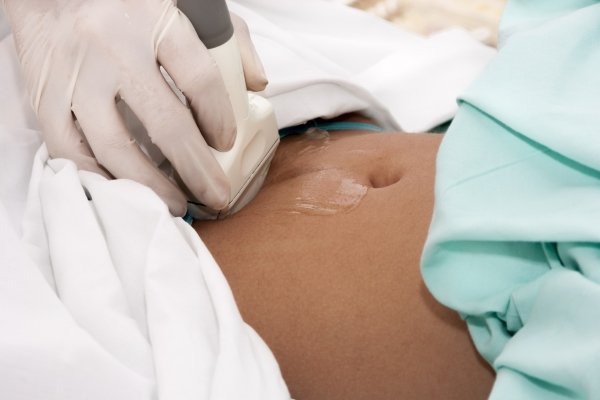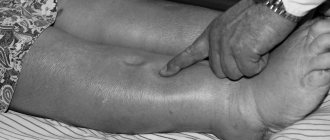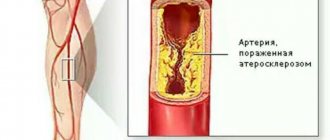- Forms and degrees of the disease
- Causes
- Symptoms
- Features of pelvic varicose veins during pregnancy
- Possible complications and consequences
- Diagnosis and treatment rules
- Prevention measures
Varicose veins of the pelvis in women are not so rare, but it is not always possible to diagnose the pathology in a timely manner. This is due to the fact that the vessels are located inside the small pelvis. Therefore, they are not visible. Feature - the symptoms resemble signs of gynecological disorders.
Forms and degrees of the disease
Varicose veins in the pelvic organs have other names - female varicocele, pelvic venous congestion, etc. With this pathology, blood circulation in the labia, vagina, uterus, ovaries, appendages and other pelvic organs is disrupted. Peculiar nodules form due to stagnation. You can see in the photo how varicose veins of the small pelvis appear externally.
Varicose veins of the pelvic organs (VMT) come in the following forms :
- The primary form occurs against the background of valvular insufficiency. May be acquired or congenital.
- The secondary type develops due to the presence of gynecological diseases.
According to the severity, pelvic varicose veins are divided into the following stages :
- Degree No. 1 is characterized by dilatation (expansion) of the veins to a diameter of half a centimeter. The passages become tortuous, any plexus is affected.
- Degree No. 2. The vessels expand to a maximum diameter of 1 cm. The lesion affects the ovarian plexus or arcuate and parametric veins.
- Degree No. 3. Feature – the diameter of the vessels expands by more than 1 cm. The lesion is considered total.
Medical diagnosis of pathology
According to studies by American scientists conducted at the beginning of the last century, only 1% of patients with varicose veins of the pelvic organs were diagnosed the first time.
Quite often, misdiagnosis led to the need to remove reproductive organs from women. This would not have happened if internal varicose veins had been diagnosed using the following methods:
- Ultrasound examination and Dopplerography of veins allow one to suspect inflammation at its earliest stages; duplex scanning and venography - a surgical examination that allows you to accurately confirm or refute the presence of a problem;
- laparoscopic scanning of the veins is an indispensable study for the comprehensive diagnosis of ARVMT; it can be used to recognize the disease among other female diseases;
- Ovariography using the selection method allows you to assess the condition of the venous walls by injecting a special substance into the vessels, it allows you to determine URVMT up to degree 2;
- computer diagnostics has the most positive reviews in identifying pelvic varicose veins; This type of examination makes it possible to see in detail the process of the disease.
With this method, it is almost impossible to confuse the disease with other pathologies that have a similar clinical picture.
Causes
The main reason is pathological disorders in the circulatory system. There are factors that contribute to the development of varicose veins in the pelvic organs:
- Onset of pregnancy. In this case, the woman’s body undergoes significant changes. Also, the uterus increases in size, puts pressure on the vessels, forming congestion.
- A congenital form of dysplasia in connective tissues.
- Hereditary predisposition. For example, weak tone in the veins, underdevelopment of the valve apparatus, fragility of the walls.
- Bearing two fruits at the same time.
- Frequent childbirth and abortion, complicated labor.
- Inactivity also leads to stagnation of lymphatic and blood fluid.
- Excessive physical activity, sudden heavy lifting, strength sports.
- Gynecological pathologies – endometriosis, fibroids, cysts, any inflammatory processes, infectious diseases. As well as uterine inflection and retroflexion.
- Therapy with hormonal drugs, taking contraceptives. Steroid drugs have a negative effect on the circulatory system.
- Dysfunctions of a sexual nature – lack of orgasm for a long time, interrupted sexual intercourse.
Symptoms
Symptoms of varicose veins of the pelvic organs in the initial stages are almost invisible. Therefore, pathology can be detected through a random examination.

However, as it progresses, the symptoms begin to appear as follows:
- a disrupted menstrual cycle (irregularity) should alert you;
- during menstruation, a woman may experience severe pain symptoms that have not been observed before;
- menstruation may be excessively heavy or prolonged;
- impaired urination;
- abundance of mucous discharge, sometimes streaked with blood;
- the pain syndrome is not severe, but is constant, it is almost impossible to relieve it with analgesics;
- pain is localized in the lower abdomen, spreads to the groin, lower back, sacrum;
- physical activity and simply walking or standing on your feet for a long time contribute to increased pain;
- in the later stages, spider veins form in the abdominal area;
- wounds and scratches do not heal well;
- pigmentation of the skin occurs;
- A hormonal imbalance occurs, causing the voice to become rougher, menstruation to stop, and hair on the skin to begin to grow.
Symptoms appear gradually, the pain is increasing in nature - the more the pathology progresses, the more symptoms appear.
Symptoms of varicose veins of the pelvis
In the first stages of the pathological process, varicose veins of the pelvic veins in the fair sex are manifested by sharp pain localized in the lower abdomen, as well as the appearance of a large number of specific vaginal discharges. Pain can often radiate to the groin and lumbar region.
In addition, this pathology is characterized by the presence of the following clinical signs:
With further progression of the pathological process, symptoms appear such as swelling of the vaginal area, a feeling of heaviness and discomfort in the pelvis, an increase in venous nodes localized in the area of the buttocks, perineum and inner thigh.
Please note: the symptoms of pelvic varicose veins are in many ways similar to the manifestations of other dangerous pathologies, such as uterine fibroids, endometriosis, and uterine prolapse. Therefore, only a qualified specialist can make a correct diagnosis and prescribe effective treatment for a specific clinical case, after preliminary comprehensive diagnostics!
Features of pelvic varicose veins during pregnancy
Most often, pelvic varicose veins occur during pregnancy. During the first pregnancy, the figure reaches 30%, during the second pregnancy – 50%.
Causes of varicose veins of the pelvic organs during pregnancy:
- Compression of blood vessels in the pelvic area due to the growth of the uterus. Most often, the disease develops already in the third trimester. The outflow of blood fluid is disrupted, blood circulation stops, and the valve mechanism does not work.
- Increased blood flow as the fetus needs it. Varicose veins develop if a woman has a predisposition to venous insufficiency. Increased blood flow loads prevent the valves from functioning normally.
- During pregnancy, hormonal levels change - the body intensively produces hormones that provoke relaxation of the walls of the veins. This happens even in the first trimester.
- The presence of congenital disorders of the circulatory system.
- Smoking and alcohol abuse during pregnancy have a particularly negative effect on the walls of blood vessels.
- The presence of inflammatory processes in the reproductive system.
- Infection.

Varicose vessels in the pelvic organs during pregnancy are dangerous. If treatment is not promptly addressed, the following may occur:
- development of thrombophlebitis and thromboembolism;
- fetal hypoxia;
- fetoplacental insufficiency;
- rupture of blood vessels and subsequent bleeding during labor;
- premature birth;
- spontaneous termination of pregnancy;
- internal bleeding during pregnancy.
Due to such a huge number of complications, a woman will be prohibited from giving birth naturally. Therefore, a caesarean section will be scheduled.
Treatment of varicose veins during pregnancy is specific, since during this period it is prohibited to use many groups of drugs. Moderate activity, physical therapy and proper nutrition are a must. Hot baths are prohibited. It is important to wear special compression garments and take certain medications. Phlebotonics such as Detralex and Phlebodia are suitable for pregnant women.
Read more about identifying and treating varicose veins during pregnancy here.
Diagnosis and treatment rules
If you do not know that you have varicose veins, first contact a gynecologist, who, after examination and diagnosis, will refer you to a phlebologist. In some cases, a consultation with a urologist is necessary. Treatment is carried out by a vascular surgeon, phlebologist, nutritionist and physiotherapist.
Diagnostic measures:
- First of all, an ultrasound examination is performed, which allows one to evaluate pathological disorders in the pelvic organs.
- Dopplerography, which is carried out along with ultrasound examinations, allows us to determine the degree of blood circulation and the functionality of the valve mechanism.
- The laparoscopic examination technique establishes an accurate diagnosis and detects concomitant diseases. During the procedure, the cavity of the pelvic organs is examined. A microscopic puncture is made in the abdominal wall and an endoscope is inserted.
- Transuterine venography fully examines blood vessels using a contrast agent. There is a contraindication - intolerance to iodine, which is contained in the contrast.
- Ovaricography, that is, radiography using a contrast agent.

The essence of therapy is as follows:
- relief of symptoms;
- strengthening the walls of blood vessels;
- normalization of vein tone;
- elimination of stagnation;
- improvement of tissue trophism;
- acceleration of blood circulation;
- prevention of relapse and development of complications.
Treatment with traditional methods
Treatment of varicose veins of the small pelvis is carried out comprehensively. The general scheme includes several methods simultaneously.
Drug therapy:
- Phlebotonics and phleboprotectors eliminate inflammatory processes, accelerate the outflow of lymph and blood, improve the tone and elasticity of arterial walls. They also have rheological and anti-destructive effects. Well-known products: “Detralex”, “Venoruton”, “Endothelon”, “Phlebodia”, “Diosmin”.
- Nonsteroidal anti-inflammatory drugs neutralize inflammation and eliminate pain: Ibuprofen, Nise, Ketonal.
- Antiplatelet drugs accelerate blood circulation and thin the blood: “Aspirin”, “Actovegin”, “Trental”, “Pentylyl”, “Pentoxifylline”.
- Enzyme preparations: Wobenzym, Phlogenzyme.
- Vitamin premixes: “Ascorutin” and so on.
- To bind toxins, enterosorbents are used: “Activated carbon”, “Polysorb”, “Smecta”.
- To neutralize swelling, Escusan is needed.
Proper nutrition. The doctor will definitely prescribe a special diet that excludes everything fried and smoked, spicy and salty, pickled and canned. You should not consume fatty meat and fish products, lard. Vegetables, cereals, fruits and lean meats, fish, and vegetable oils are allowed. All dishes must be cooked by steam, water or in the oven.
Compression. You should definitely wear compression garments. This is the most important condition for varicose veins in any part of the body. The linen is selected by your attending physician depending on the severity of the disease. The fact is that such clothes have different degrees of compression.
Sports activities. The doctor prescribes physical therapy, which includes special exercises and breathing exercises. Among the simple exercises that you can do on your own, it is worth noting:
- Bicycle type exercise. You need to take a lying position - on your back. Place your arms behind your head and lift your legs up. Next, imitate the movements of a cyclist pedaling.
- The second exercise is also from the school curriculum - birch tree. Lie on your back, raise your legs and throw them over your head. Next, begin to slowly raise your torso with your legs, taking a vertical position. Hold the pose for a couple of minutes.
- Another simple exercise is scissors. Pose - on your back, legs straight and slightly raised above the floor. Imitate the movement of scissors.
In this video you can learn about yoga for varicose veins of the small pelvis. Here are some exercises that, in combination with other treatment methods, will help you improve your condition.
Surgical intervention. Surgery is used for advanced degrees of severity, during pregnancy and in the absence of a positive result after traditional methods of therapy. There are several methods:
- Embolization of damaged vessels in the ovary, that is, ligation. A laparoscope is used.
- Resection (removal, partially or completely) of blood vessels. The retroperitoneal or laparoscopic access method is used.
- Vein clipping – the vessel is clamped with special clips.
- Vein ligation – crossectomy.
- Scleroobliteration of blood vessels is performed along with angiography to monitor the progress of the operation. A sclerosing agent is injected into a vein to block the affected artery.
The method of surgery is selected on an individual level.
Folk remedies
Traditional medicine recommends the following:
- Drink a drink made from chaga kombucha. It perfectly tones blood vessels and strengthens the walls of veins.
- Buy horse chestnut tincture at the pharmacy and take it orally. This remedy can also be made at home.
- Hirudotherapy (treatment with leeches) is also useful.
Drug therapy
It is drug therapy that needs to be given due attention, emphasizing the fact that in no case should the patient decide on his own what medications he will take.
The most important drug used for this disease is considered to be venotonic, which is prescribed in certain courses, no more than 3 months at a time.
Among venotonics we can distinguish such drugs as detralex, chimes, ginkor-forte. All these drugs are combined and have a complex effect on the body, working in different directions.
Hormone therapy
For some reason, many people are scared by the words hormone therapy, fearing that excess weight will appear. In fact, modern drugs are selected individually, and if weight gain occurs, it is only by a few kilograms, but nothing more.
Surgery
With varicose veins of the small pelvis, sometimes surgical intervention is simply necessary, which will help avoid the consequences that come with diseases associated with the veins. The operation can have two types, depending on the stages of the disease:
- Ligation of the venous plexuses to prevent the disease from expanding.
- Embolization, that is, a full-fledged operation that is performed through the inner thigh.
It should be noted that, unfortunately, medicine is not yet very developed in this area, and therefore, even after surgery, relapses often occur within 6 months.
As practice shows, after 3 relapses and, accordingly, 3 operations, the disease ceases to make itself felt and the process of improving the body’s condition begins. In any case, it is important to consult a doctor in a timely manner and not self-medicate, because otherwise you can harm your own body even more. Only timely contact with a specialist will help get rid of the disease as soon as possible.
About varicose veins (video)
Prevention measures
For preventive purposes, it is recommended to adhere to the following rules:
- Lead an active lifestyle.
- Avoid constipation, as it contributes to the development of varicose veins in the colon (hemorrhoids), after which varicose veins develop in the pelvis.
- Eat right - eat more plant fiber.
- Take a contrast shower.
- If you have a predisposition to varicose veins, take preventive venotonics periodically (prescribed by your doctor).
Varicose veins of the pelvic vessels are common, but they are difficult to diagnose. Therefore, it is important to contact the clinic in a timely manner and provide adequate treatment, because the sooner you start fighting the disease, the easier it is to defeat it.











